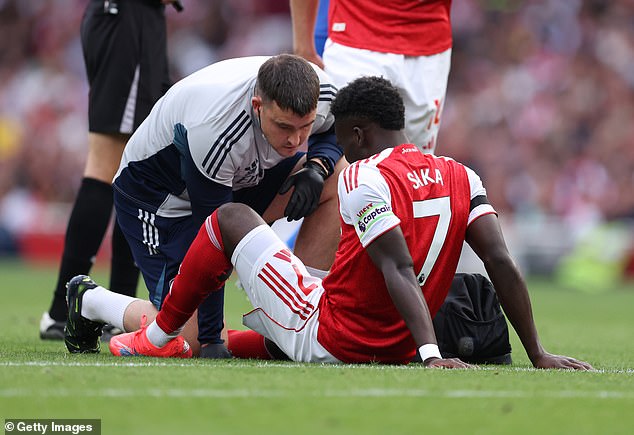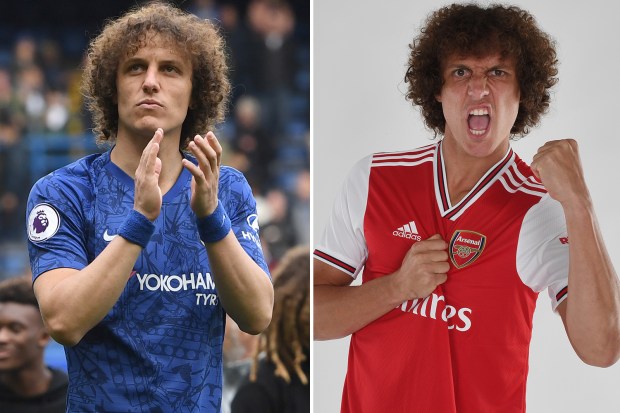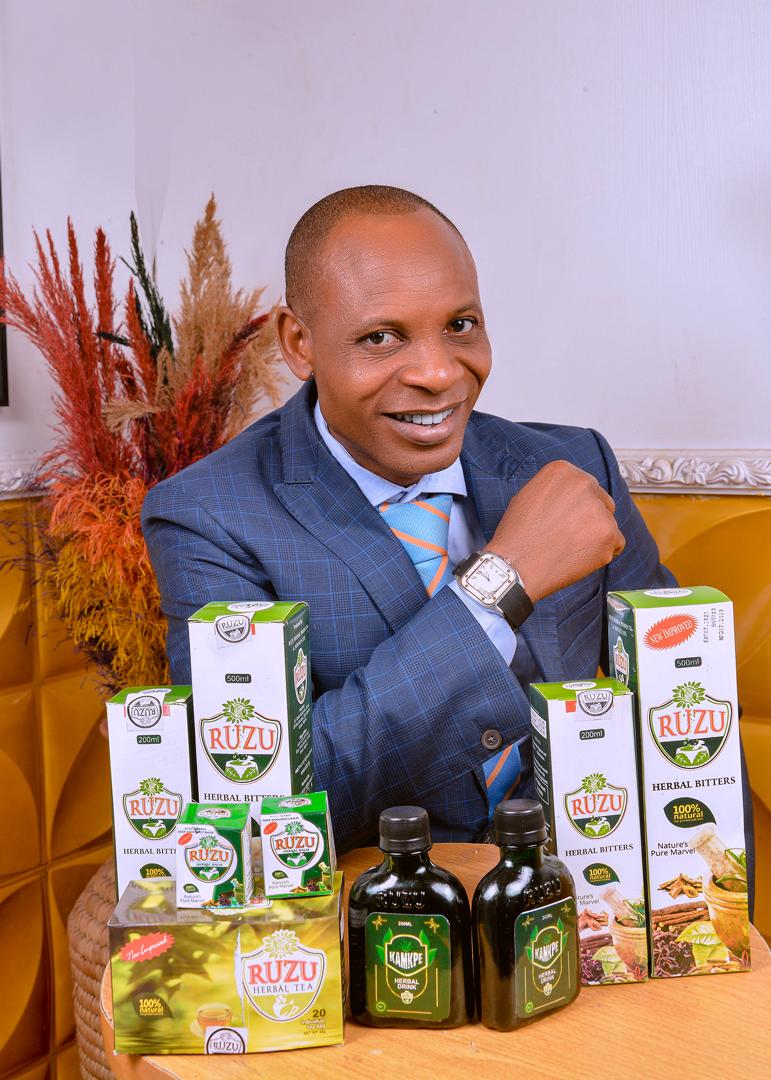In a significant blow to Arsenal’s Premier League campaign, star winger Bukayo Saka is expected to be sidelined for up to four weeks due to a hamstring injury sustained during the team’s emphatic 5-0 victory over Leeds United on Saturday. The injury, which forced the 27-year-old England international to hobble off the pitch, has raised concerns about Arsenal’s attacking options as they prepare for a critical match against Liverpool at Anfield this Sunday. Adding to the Gunners’ woes, captain Martin Odegaard also left the Leeds game early with a shoulder injury, while forward Kai Havertz remains out with a knee injury sustained earlier in the season. Manager Mikel Arteta’s post-match comments underscored the severity of the situation, particularly regarding Saka’s condition, as the club braces for a challenging period without key players.
This latest injury crisis threatens to derail Arsenal’s momentum in a highly competitive Premier League season, where they are vying for the title against formidable rivals like Liverpool and Manchester City. The absence of Saka, a pivotal figure in Arsenal’s attacking setup, and Odegaard, the team’s creative linchpin, could test the squad’s depth and resilience. This article explores the details of the injuries, their implications for Arsenal’s campaign, and the broader context of the club’s ongoing battle with injuries in the 2025-26 season.
The Incident: Saka’s Hamstring Injury
The injury to Bukayo Saka occurred during Arsenal’s dominant performance against Leeds United at the Emirates Stadium. The Gunners were in scintillating form, securing a 5-0 victory that showcased their attacking prowess and defensive solidity. However, the joy of the result was overshadowed by Saka’s early exit from the game. The 27-year-old winger, known for his pace, dribbling, and goal-scoring ability, was seen clutching his left hamstring after a sprint with the ball in the second half. Unable to continue, he limped off the pitch, replaced by a substitute, as Arsenal fans watched with bated breath.
Post-match, manager Mikel Arteta provided a sobering update on Saka’s condition, fueling concerns about the severity of the injury. “Bukayo was running with the ball, and he felt something in his hamstring. It’s the other one, not the same as last season. He felt something when sprinting; it’s not a good sign,” Arteta told reporters. “We have to wait to understand how long he will be out. I haven’t spoken to the doctor yet, but for Bukayo to come off, it’s significant.” Arteta’s comments highlighted the rarity of Saka leaving a match due to injury, underscoring the winger’s importance to the team and the potential impact of his absence.
According to a report by BBC Sport, Saka’s injury has been diagnosed as a hamstring problem, with an expected recovery period of three to four weeks. While this timeline is more favorable than initially feared, it means Saka will miss several key fixtures, including Arsenal’s high-stakes trip to Liverpool, a match that could have significant implications for the Premier League title race. The injury is to Saka’s left hamstring, distinct from a previous hamstring issue he suffered last season, which affected his right leg. This distinction offers some reassurance, as it suggests the injury is not a recurrence of a chronic problem, but the timing remains a major setback for Arsenal.
Odegaard’s Shoulder Injury Adds to Arsenal’s Woes
Compounding Arsenal’s injury concerns, captain Martin Odegaard also left the Leeds match early, clutching his right shoulder. The Norwegian midfielder, who has been a cornerstone of Arsenal’s midfield since joining from Real Madrid in 2021, was seen in discomfort after a challenge in the first half. Following the game, Odegaard left the Emirates Stadium with his right arm in a sling, raising fears about the extent of his injury. While Arteta did not provide a detailed update on Odegaard’s condition post-match, the sight of the captain in a sling has sparked concern among fans and pundits alike.
Odegaard’s potential absence is particularly troubling given his role as Arsenal’s creative hub. The 27-year-old has been instrumental in orchestrating the team’s attacking play, providing vision, precision, and leadership in midfield. His ability to link defense and attack, combined with his knack for scoring crucial goals, has made him indispensable to Arteta’s system. If Odegaard is sidelined for an extended period, Arsenal will need to rely on less experienced or less suited players to fill the void, a challenge that could disrupt the team’s rhythm and cohesion.
Havertz’s Ongoing Absence
The injuries to Saka and Odegaard come on the heels of another significant blow to Arsenal’s squad: the knee injury sustained by forward Kai Havertz during the opening weekend of the 2025-26 Premier League season. Havertz, who scored in Arsenal’s victory over Manchester United, has been ruled out for an unspecified period, with no clear timeline for his return. The German international, who has evolved into a versatile and prolific forward under Arteta’s guidance, is a key component of Arsenal’s attacking setup. His absence has already forced tactical adjustments, with players like Gabriel Jesus and Leandro Trossard stepping into more prominent roles.
The simultaneous absence of Saka, Odegaard, and Havertz represents a significant challenge for Arsenal, as the trio forms the backbone of the team’s attacking unit. Saka’s pace and directness on the right flank, Odegaard’s creativity in midfield, and Havertz’s versatility up front are integral to Arsenal’s high-pressing, fluid style of play. With all three players potentially unavailable for the upcoming Liverpool match, Arteta faces a daunting task in maintaining the team’s competitiveness against one of the Premier League’s strongest sides.
The Broader Context: Arsenal’s Injury Challenges
The injuries to Saka, Odegaard, and Havertz are the latest in a series of setbacks that have tested Arsenal’s squad depth in recent seasons. The 2025-26 campaign has been particularly challenging, with several key players missing time due to injuries. Earlier in the season, defender Gabriel Magalhães suffered a minor ankle issue, while midfielder Declan Rice was briefly sidelined with a calf strain. The recurring nature of injuries, particularly to key players like Saka, has raised questions about the team’s training methods, fixture congestion, and the physical demands of modern football.
Saka, in particular, has been a near-ever-present figure for Arsenal, rarely missing matches due to his durability and professionalism. His previous hamstring injury last season, which kept him out for a few weeks, was a rare occurrence, and his current injury underscores the physical toll of playing at the highest level. The fact that the injury is to his opposite hamstring suggests it may be related to the intense workload Saka has shouldered, both for Arsenal and the England national team. As a key player in Gareth Southgate’s squad, Saka has been a regular starter in major tournaments, including the 2022 and 2026 World Cups, adding to his physical and mental demands.
Odegaard’s shoulder injury, meanwhile, raises concerns about the physicality of the Premier League and the challenges of protecting creative players from robust challenges. As Arsenal’s captain, Odegaard often faces intense pressure from opponents seeking to disrupt his influence on the game. The use of a sling suggests a possible dislocation or strain, which could require careful management to prevent long-term complications.
Havertz’s knee injury, sustained in the season opener, highlights the unpredictable nature of injuries in football. The German’s absence has already forced Arteta to experiment with different formations, including deploying Jesus as a central striker and Trossard in a more advanced role. While Arsenal’s squad depth has improved in recent years, the simultaneous loss of three key attackers tests the team’s ability to adapt and maintain its attacking potency.
Implications for Arsenal’s Season
The injuries to Saka, Odegaard, and Havertz come at a critical juncture in Arsenal’s season. The Gunners have enjoyed a strong start to the 2025-26 Premier League campaign, sitting near the top of the table after a series of impressive performances, including the 5-0 thrashing of Leeds. However, the upcoming match against Liverpool at Anfield represents a significant test of their title credentials. Liverpool, under their current manager, have been a formidable force, blending attacking flair with defensive resilience. A victory at Anfield could solidify Arsenal’s position as genuine title contenders, while a defeat could dent their momentum and confidence.
Without Saka, Arsenal lose a dynamic winger who has consistently delivered goals and assists. His ability to stretch defenses, cut inside from the right, and create chances for teammates is unmatched within the squad. Players like Reiss Nelson or Gabriel Martinelli may be called upon to fill the void, but neither possesses Saka’s combination of experience, consistency, and big-game mentality. Martinelli, in particular, has shown flashes of brilliance but has struggled with consistency in recent seasons, while Nelson remains a squad player with limited starting experience.
Odegaard’s potential absence further complicates Arsenal’s strategy. The Norwegian’s vision and passing range are central to the team’s attacking structure, and his leadership on the pitch is invaluable. Midfielders like Emile Smith Rowe or Fabio Vieira could step in, but they lack Odegaard’s experience and composure in high-pressure situations. Arteta may also consider tactical adjustments, such as deploying Rice in a more advanced role or relying on Thomas Partey to provide stability in midfield.
Havertz’s ongoing absence adds another layer of complexity. The German’s versatility allows him to play as a false nine, a traditional striker, or an attacking midfielder, providing Arteta with tactical flexibility. Without Havertz, Arsenal’s attacking options are limited, particularly in terms of aerial presence and physicality. Jesus, while a capable replacement, has struggled with injuries and inconsistency in front of goal, while Trossard is better suited to a wide role.
The Liverpool match is just one of several challenging fixtures Arsenal face in the coming weeks. The team’s schedule includes clashes with top teams like Manchester City, Tottenham Hotspur, and Chelsea, as well as crucial matches in the UEFA Champions League. The absence of Saka, Odegaard, and Havertz could have a ripple effect, impacting Arsenal’s performance across multiple competitions. Arteta will need to rely on his squad’s depth and the leadership of players like Rice, Gabriel, and William Saliba to navigate this difficult period.
Arteta’s Response and Tactical Adjustments
Mikel Arteta, known for his meticulous preparation and adaptability, faces one of the biggest challenges of his managerial career. The Spaniard has transformed Arsenal into a competitive force since taking charge in 2019, guiding the team to the FA Cup in 2020 and consistently challenging for the Premier League title in recent seasons. However, the current injury crisis tests his ability to manage adversity and maintain the team’s momentum.
Arteta’s post-match comments about Saka’s injury reflect his concern but also his pragmatism. By acknowledging the significance of Saka’s exit from the Leeds game, Arteta signaled his awareness of the challenges ahead. His decision to wait for the medical team’s assessment before speculating on the recovery timeline suggests a measured approach, avoiding panic while preparing for various scenarios.
To compensate for the absences, Arteta may need to make significant tactical adjustments. One option is to shift to a more defensive setup, relying on the solidity of players like Saliba and Gabriel at the back while using Rice to anchor the midfield. This approach could help Arsenal absorb pressure at Anfield and hit Liverpool on the counterattack, with players like Martinelli and Trossard providing pace on the flanks. Alternatively, Arteta could promote younger players from the academy, such as Ethan Nwaneri, who has shown promise in limited appearances.
The manager’s ability to galvanize the squad will be crucial. Arsenal’s dressing room is known for its unity and resilience, qualities that have been honed under Arteta’s leadership. By instilling confidence in his players and leveraging the squad’s depth, Arteta can mitigate the impact of the injuries and keep Arsenal competitive.
The Bigger Picture: Injuries in Modern Football
The injuries to Saka, Odegaard, and Havertz are part of a broader trend in modern football, where players face increasing physical and mental demands. The Premier League’s intensity, combined with the congested fixture schedule of domestic and European competitions, places immense strain on players. The 2025-26 season, with its expanded UEFA Champions League format and international tournaments like the 2026 World Cup, has further exacerbated these challenges.
Hamstring injuries, like the one suffered by Saka, are among the most common in football, often resulting from sprinting, sudden changes in direction, or fatigue. The fact that Saka’s injury is to a different hamstring than his previous issue suggests it may be related to workload rather than a chronic condition, but it raises questions about Arsenal’s training and recovery protocols. Clubs across Europe have invested heavily in sports science to prevent such injuries, but the relentless pace of modern football makes it difficult to eliminate them entirely.
Odegaard’s shoulder injury highlights the physicality of the Premier League, where midfielders often face robust challenges from opponents. Protecting creative players like Odegaard requires not only tactical adjustments but also stronger officiating to deter dangerous tackles. Havertz’s knee injury, meanwhile, underscores the unpredictable nature of contact injuries, which can occur in any match regardless of a player’s physical condition.
The broader issue of fixture congestion also warrants attention. The expansion of club competitions, combined with international breaks, leaves players with little time to recover between matches. For players like Saka, who are key figures for both club and country, the risk of burnout and injury is particularly high. The footballing authorities, including the Premier League, UEFA, and FIFA, must address these concerns by reevaluating the calendar and prioritizing player welfare.
Fan and Pundit Reactions
The injuries to Saka, Odegaard, and Havertz have sparked a range of reactions from Arsenal fans and pundits. On social media platforms like X, supporters have expressed a mix of concern and optimism. Some, like @GoonerViews, have called for Arteta to trust younger players like Nwaneri, arguing that the crisis presents an opportunity for the next generation to shine. Others, such as @ArsenalFanatic, have voiced frustration at the team’s recurring injury problems, questioning whether the medical staff and training regime need an overhaul.
Pundits have also weighed in, with former Arsenal player Ian Wright emphasizing Saka’s importance to the team. “Bukayo is the heartbeat of this Arsenal side,” Wright said on BBC’s Match of the Day. “His energy, his creativity, his goals—they’re massive. Three to four weeks is better than three to four months, but it’s still a huge blow.” Gary Lineker, meanwhile, praised Arteta’s ability to adapt, noting that the manager has faced similar challenges in the past and found ways to keep Arsenal competitive.
Looking Ahead: Arsenal’s Path Forward
As Arsenal prepare for their clash with Liverpool, the focus will be on how Arteta navigates the absence of Saka, Odegaard, and Havertz. The Liverpool match is a litmus test for Arsenal’s title aspirations, and a positive result—whether a win or a draw—could boost the team’s confidence. However, the broader challenge lies in managing the squad over the next month, with a packed schedule that includes domestic and European fixtures.
The return of other players, such as Rice and Gabriel, will provide some relief, but Arteta must carefully manage their minutes to avoid further injuries. The emergence of young talents like Nwaneri and the versatility of players like Trossard and Jesus will be crucial in maintaining Arsenal’s attacking threat. Off the pitch, the club’s medical team will need to work diligently to ensure that Saka, Odegaard, and Havertz return as soon as possible without risking long-term complications.
In the long term, Arsenal may need to reassess their approach to player management, including training loads, recovery periods, and rotation strategies. Investing in sports science and injury prevention programs could help reduce the frequency of setbacks, ensuring that key players like Saka remain available for crucial matches.
Conclusion: A Test of Resilience
The injuries to Bukayo Saka, Martin Odegaard, and Kai Havertz represent a significant challenge for Arsenal as they navigate a pivotal moment in their season. The loss of three key players, particularly ahead of a high-stakes match against Liverpool, tests the squad’s depth, Arteta’s tactical acumen, and the team’s mental fortitude. However, Arsenal’s recent history under Arteta suggests that they are capable of overcoming adversity, with a strong squad and a unified dressing room.
The broader context of injuries in modern football underscores the need for systemic changes to protect players and ensure their longevity. For now, Arsenal must focus on the immediate challenge, rallying around their available players and trusting in Arteta’s leadership to guide them through this difficult period. As the Gunners prepare to face Liverpool and beyond, their ability to adapt and persevere will define their season and their pursuit of Premier League glory.






